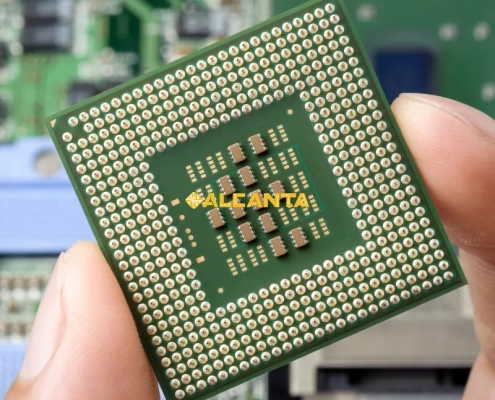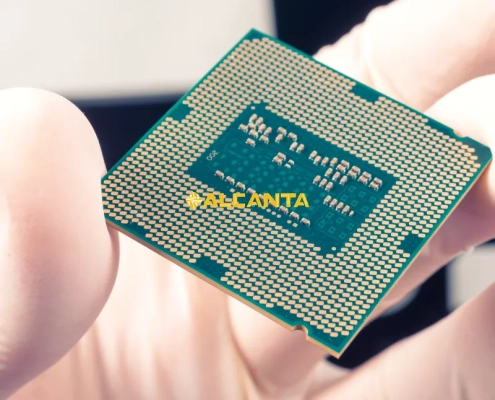FR4 Substrate: A Crucial Element in PCB Manufacturing
The manufacturing of modern electronic devices heavily relies on Printed Circuit Boards (PCBs), with FR4 substrates being one of the most commonly used substrate materials. FR4 substrates, composed of flame-retardant epoxy reinforced with woven glass fibers, exhibit exceptional mechanical strength and stability. Their excellent insulating properties make them ideal for providing electrical connections while ensuring safety and reliability in diverse environments. FR4 substrates play a pivotal role in supporting and protecting electronic components, facilitating efficient circuit design and layout. Their widespread adoption across industries such as telecommunications, automotive electronics, and medical devices underscores their significance in modern electronics manufacturing.
What is FR4 Substrate?
Advantages of FR4 Substrates
Applications of FR4 Substrates
Telecommunication Equipment: FR4 substrates find extensive use in telecommunication equipment, including routers, switches, and base stations. Their excellent mechanical strength and stability, coupled with superior insulating performance, make them well-suited for the demanding requirements of telecommunications infrastructure. FR4 substrates provide a reliable platform for mounting and interconnecting electronic components, ensuring the integrity and performance of communication systems. Additionally, their thermal resistance and flame retardancy are essential for maintaining operational safety, especially in telecommunications facilities where continuous operation is critical.
Automotive Electronics: In the automotive industry, FR4 substrates play a vital role in various electronic components and systems, ranging from engine control units (ECUs) to infotainment systems. The ruggedness and durability of FR4 substrates make them ideal for automotive applications, where they must withstand harsh environmental conditions such as temperature fluctuations, humidity, and vibration. FR4 substrates provide a stable and secure platform for mounting sensitive electronic components, ensuring reliable performance in vehicles. Moreover, their cost-effectiveness and compatibility with automated assembly processes contribute to their widespread adoption in automotive electronics manufacturing.
Industrial Control Systems: FR4 substrates are commonly used in industrial control systems, including programmable logic controllers (PLCs), motor drives, and instrumentation panels. The high dielectric strength and insulation properties of FR4 substrates make them suitable for controlling and monitoring electrical equipment in industrial settings. FR4 substrates provide a robust and reliable platform for integrating complex circuitry, facilitating efficient operation and maintenance of industrial control systems. Their thermal resistance and flame retardancy are particularly important in industrial environments where equipment reliability and safety are paramount.
Medical Devices: FR4 substrates are employed in various medical devices and equipment, including patient monitoring systems, diagnostic instruments, and imaging devices. The biocompatibility and reliability of FR4 substrates make them well-suited for medical applications, where precision and safety are critical requirements. FR4 substrates provide a stable and sterile platform for mounting electronic components, ensuring accurate and consistent performance in medical devices. Additionally, their thermal resistance and flame retardancy enhance the safety and reliability of medical equipment, particularly in environments where sterilization and disinfection procedures are employed. Overall, FR4 substrates play a crucial role in advancing healthcare technology and improving patient care.
Disadvantages of FR4 Substrates
Low Thermal Conductivity: One of the significant disadvantages of FR4 substrates is their low thermal conductivity. Due to the insulating nature of the epoxy resin matrix and the relatively low thermal conductivity of glass fibers, FR4 substrates exhibit poor heat dissipation properties. This can lead to localized hotspots and thermal stress buildup in electronic devices, especially those with high power densities or operating at elevated temperatures. In applications where efficient heat dissipation is crucial for device performance and reliability, alternative substrate materials with higher thermal conductivity, such as metal core or ceramic substrates, may be preferred over FR4.
Unsuitability for Extreme Environments: FR4 substrates are not well-suited for use in extreme environmental conditions, such as high humidity, corrosive atmospheres, or extreme temperatures. While FR4 substrates offer good resistance to moisture absorption and chemical exposure under normal operating conditions, they may degrade or experience performance degradation in harsh environments. Excessive moisture absorption can compromise the mechanical and electrical properties of FR4 substrates, leading to delamination, dimensional changes, and reduced insulation resistance. Similarly, exposure to corrosive chemicals or prolonged exposure to high temperatures can accelerate the degradation of FR4 substrates, limiting their lifespan and reliability.
Complex Forming Processes: The manufacturing processes involved in producing FR4 substrates can be complex and require specialized equipment and expertise. The lamination process, which involves bonding layers of epoxy resin and glass fiber reinforcement under heat and pressure, must be carefully controlled to ensure uniformity and quality. Additionally, the drilling and machining of FR4 substrates to create circuit patterns and vias require precision equipment and skilled operators to avoid damage or defects. The complexity of forming processes for FR4 substrates can result in higher production costs and longer lead times compared to simpler substrate materials. Furthermore, the intricate nature of FR4 substrates may limit their suitability for certain design configurations or applications that require unconventional shapes or dimensions.
Role of FR4 Substrates in PCBs
Providing Electrical Connections: FR4 substrates serve as the foundation for creating electrical connections within a Printed Circuit Board (PCB). The substrate acts as an insulating base upon which conductive traces, typically made of copper, are etched or deposited. These traces form the electrical pathways that connect various electronic components, such as integrated circuits (ICs), resistors, and capacitors, within the PCB. The insulating properties of the FR4 substrate prevent short circuits and ensure the integrity of the electrical connections, enabling proper functioning of the electronic device.
Supporting and Protecting Electronic Components: Another crucial role of FR4 substrates in PCBs is to support and protect electronic components mounted on the board. FR4 substrates provide a rigid and stable platform for securely mounting components through soldering or other attachment methods. The mechanical strength and stability of the substrate help prevent components from shifting or becoming dislodged during handling or operation. Additionally, the insulating properties of the FR4 substrate protect electronic components from electrical interference and damage, ensuring reliable performance and longevity of the PCB.
Facilitating Circuit Design and Layout: FR4 substrates play a key role in facilitating the design and layout of circuits on a PCB. The flat, uniform surface of the substrate provides a blank canvas for engineers and designers to layout the circuitry according to the desired schematic diagram. The substrate’s dimensional stability and consistent material properties allow for precise placement of components and routing of traces. Designers can optimize the layout to minimize signal interference, reduce parasitic capacitance, and improve overall circuit performance. Furthermore, the compatibility of FR4 substrates with standard fabrication processes, such as etching, drilling, and soldering, streamlines the manufacturing of complex PCB designs, enabling rapid prototyping and production of electronic devices. Overall, FR4 substrates play a crucial role in realizing the functionality and performance of PCBs, from initial design to final assembly.
Common Thicknesses and Specifications of FR4 Substrates
Standard Thickness: FR4 substrates are available in a range of standard thicknesses to accommodate various PCB designs and applications. Common standard thicknesses for FR4 substrates typically range from 0.2mm to several millimeters. The choice of thickness depends on factors such as the complexity of the circuitry, the size of the PCB, and the mechanical requirements of the end product. Thinner substrates are often used for applications where space is limited or weight reduction is a priority, while thicker substrates may be preferred for applications requiring higher mechanical strength or thermal stability. Manufacturers typically offer standard thickness options to meet the diverse needs of electronic designers and manufacturers.
Common Dimensional Specifications: In addition to thickness, FR4 substrates are specified by various dimensional parameters to ensure compatibility with PCB fabrication processes and assembly requirements. Common dimensional specifications include the size and shape of the substrate, as well as the location and dimensions of mounting holes, slots, and cutouts. Standard dimensional specifications for FR4 substrates are typically defined by industry standards, such as IPC-6012 for rigid PCBs, or customer-specific requirements based on the intended application. These specifications may vary depending on factors such as the type of electronic device, assembly method, and manufacturing capabilities of the PCB manufacturer. Adherence to dimensional specifications is critical to ensuring proper fit, alignment, and functionality of the final PCB assembly.
FAQs About FR4 substrate
What are the disadvantages of FR4 substrate?
The disadvantages of FR4 substrate include low thermal conductivity, unsuitability for extreme environments, and complex forming processes.
Why is FR4 used in PCB?
FR4 is used in PCBs due to its excellent mechanical strength, superior insulating performance, good thermal resistance, flame retardancy, and cost-effectiveness.
What is the standard thickness of FR4 substrate?
The standard thickness of FR4 substrate typically ranges from 0.2mm to several millimeters, depending on the specific application requirements.
Is FR4 an epoxy?
Yes, FR4 is an epoxy-based composite material consisting of a flame-retardant epoxy resin matrix reinforced with woven glass fibers.
What are the key advantages of FR4 substrate in PCB manufacturing?
FR4 substrates offer excellent mechanical strength, superior insulation, thermal resistance, and flame retardancy, making them ideal for PCBs.
Are there any drawbacks to using FR4 substrate in electronic devices?
Yes, FR4 substrates have low thermal conductivity, making them less effective at dissipating heat. They may also be unsuitable for extreme environments and require complex manufacturing processes.
What is the typical thickness of FR4 substrate used in PCB fabrication?
The standard thickness of FR4 substrate ranges from 0.2mm to several millimeters, depending on the specific requirements of the PCB design and application.
Is FR4 substrate made of epoxy?



